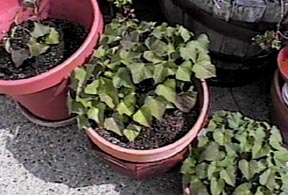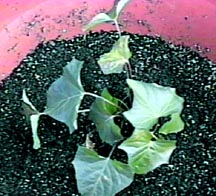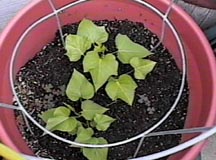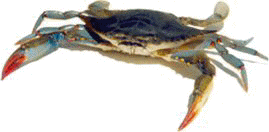
Eastern Shore of Virginia Recipes
How to Grow Eastern Shore
HAYMAN Potatoes
 |
 |
 |
Barbara Cox wrote:
Dear ghotes, especially ES Dwellers,
If a person in California happened to have one Hayman potato, and if
that person decided to try to grow more Hayman potatoes from that one,
when would be the time to plant the eyes? And can anyone tell me the
favorite soil properties and drinking habits of this particular delicacy?
Thanks very much,
Barbara
++++++++++++++++++++++++++
Bob Mears replied:
Hello my friends,
DO NOT- repeat - DO NOT cut that potato. Here is how you get new
Hayman
potato plants.
When all danger of frost is well past, put the whole potato in the ground
in
a well drained light soil with plenty of sun. Cover with 1 1/2" to
2" of
soil. Water frequently. After a week or 10 days, you should see sprouts
coming up. Water these frequently. When they are about 6" to
8" high.
remove them bare rooted and transplant to a final location. Plant sprouts
3"
to 4" deep and about 16" apart in rows. Rows can be about 20" apart
This process is called "drawing and putting out sprouts". The sprouts
are
normally grown in warm, glass covered beds on ESVA.
As the plants grow, pile dirt around them until the mound/row
is about 6"
to 8" high and a foot across. The runners will grow very long. When
the
leaves just start to turn yellow, the potato hill is ready for digging.
Let
them sit in the sun for about one week before storage. Then store them
for
another week or two in darkness before cooking. This cures the
internal
sweetness of the potato. Enjoy.
More can be propagated from the runners. Take one or two runners from
each
plant. Cut them in about one foot lengths and stick the part which
was
closest to the mother plant in the ground (about 3" -4").
This process is called "putting out slips." Survival rate
is almost 100%.
Pretty soon you will have more Hayman potatoes that you know what to
do
with. You can have enough for your whole neighborhood this way.
And when you harvest them, you must get all the roots, else you have
started the whole cycle again.
Bob
PS. Have not enjoyed one since dinner time today.
+++++++++++++++++++++++++++++++++++++++++++++++++++
In response to which, Barbara wrote:
Bob,
Thank you so much! I'm delighted to have these instructions, and I shall
do my best. I don't have much "yard." No room for a real garden. I'll
be
partially experimenting with large containers. However, if I'm lucky
with the sprouts, I might be able to "borrow" a patch of soil somewhere.
I'm hoping that since we're near a "Shore," my mother potato will be
happy.
Now I have a few questions, despite your detailed directions.
1. What is the meaning of "when all danger of frost is well past"? I
don't think this area has had frost since about 1937. I'm not being
facetious; I really need to be told the MONTH in which to plant.
2. What is the meaning of "plant the sprouts bare-rooted"? Aren't they
attached to the mother potato?
3. What about fertilizer? And is "light soil" like potting mix?
4. How many plants will come up from one poor potato? As many as it
has
eyes? (This one is a little small; we ate the big ones.)
5. How DEEP will the potatoes grow? I need to know how deep a container
to try.
6. How many potatoes will grow from one of the new plants?
7. How long is "very long" when referring to runners?
8. How often do the plants (not the sprouts) need water if there is
no
rain?
9. About how much time passes between planting the sprouts and
harvesting the potatoes?
I think that will do it for now. I'll look forward to the additional
information.
AND, may I Please put your instructions on the ghotes website??
Many thanks,
Barbara
+++++++++++++++++++++++++++++++++++++++++++++
And then Bob answered...
Hello my friends,
Especially Barbara
You must realize that I am an ex-farmboy who planted Hayman potatoes
to eat.
I am not a horticultural scientist so bear with me. I have never seen
these
grown in containers so some answers are only best guess. If you grow
them in
containers you will be the expert then.
In response to your questions:
Q1 What month to plant?
A1 Anytime, since you have no frost problems in southern
California, start
today!
Q2 Meaning of "plant bare-rooted"?
A2 When you "draw sprouts" they come away from
the parent potato leaving
it still in the ground. The small new sprout will be a new plant with
roots
attached. There is no need to dig a small amount of soil with the new
sprout
such as occurs when you buy other plants (e.g., tomatoes) in the garden
center.
Q3 Fertilizer ? Light soil?
A3 Any ordinary fertilizer will work ( 6-6-6 or similar). Do
NOT over
fertilize. A light soil means - Do not plant in a soil which can be
hard and
stiff and not allow the new potatoes to grow and swell as they mature.
ESVA
has a sandy loam which works fine for this. Maybe some ESVA dweller
will
send you a bushel of dirt for each plant you have. No no - I
am just having
fun here.
Q4 How many plants from one sweet potato?
A4 I have never tried to count them but a good guess would
be 10 - 15
maybe more. And then you have the runners for ? more. I have never
seen a
sweet potato with eyes? Size is not important to "How many?"
You should get
the same basic amount from any size parent potato.
Q5 How deep will new potatoes grow?
A5 Not more than one foot. This is purpose of mounding
dirt around plant
as they grow. I suggest each container be about one bushel sized or
more.
Maybe 1 or 2 per container. You need lots of room for the roots and
vines.
Q6 How many potatoes per plant?
A6 Varies but should average 5 to 8 in good
soil. and growing
conditions. The real question here should be "how big?". The roots
of the
plant will swell thus making potatoes. Other roots will swell slightly
thus
making fat roots. Do not ask me the difference between a fat root and
a
potato. You be the judge when it come harvest, cooking or eating time.
Q7 Runner length?
A7 Could be 12 feet or more. And many of them
Q8 How often to water?
A8 You be the judge. Do not overwater. Keep soil somewhat
dry. Water maybe
every 3 - 5 days with moderate amount. . Do not plant in a container
which
will retain water. Put holes in the bottom of the container for drainage.
Q9 Time between planting and harvesting?
A9 Growing season on ESVA is from April/May to October. Conditions
may vary
where you are.
There is one caveat in all this. The soil and conditions are just right
for
doing this on ESVA. You may or may not duplicate the goodness of a
great
Hayman potato. But then you may start a whole new industry there in
Southern
California. Who knows?
Yes. You may add the info to website. I suggest you employ your editorial
skills to digest the whole thing to something more conducive to website
size
and content. Send me a copy first please.
Bob
+++++++++++++++++++++++++++++++++++++++++++++++++
From Barbara:
Dear Bob,
Thanks so very much for the directions and tips. I'll put our exchange
up "as
written." A little long, but a good bit of fun, I think.
As ever,
Barbara
PS I'll let you know how we do!
Do you have Eastern Shore of Virginia family recipes you would like to share with readers of this web site? If so, please e-mail them to Jack Burn jackburn@swva.net . Thanks
Return to the top of this page
Return to the Eastern Shore of Virginia Recipes Index page.
Return to the GHOTES home page
 >>> Advertise Here <<<
>>> Advertise Here <<<